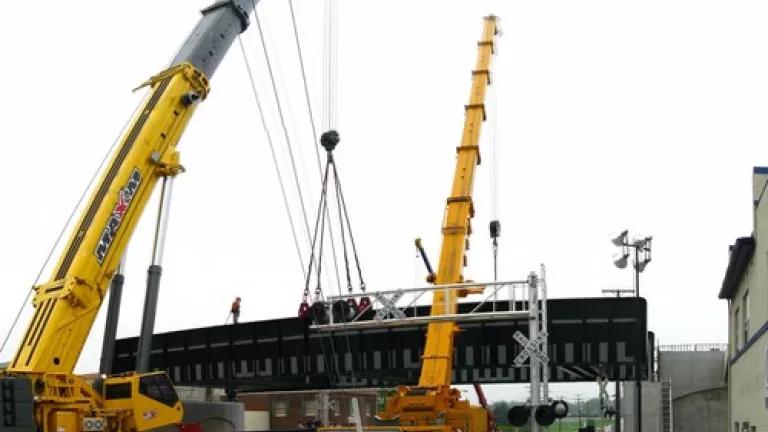
Construction in Maryland, photo courtesy of Wikimedia Commons by Thisisbossi
Yesterday I spent part of the afternoon discussing infrastructure permitting as part of “Infrastructure Week,” at the National Association of Manufacturers, with a particular focus on Philip K. Howard’s new book The Rule of Nobody. The book is provocative and thought-provoking, and hews to the dictum from famed management guru Peter Drucker that we need “effective government,” regardless of its size.
Turns out our discussion was timely, since President Obama is rolling out a new 4-point strategy today:
- Institutionalize Interagency Coordination and Transparency;
- Improve Project Planning, Siting and Application Quality;
- Improve Permitting, Reviews and Mitigation; and
- Drive Continued Improvement.
First, the Administration proposes achieving clarity on schedules, dispute resolution and who is the lead on a project. The latter is something that Howard claims is a basic problem with much government decisionmaking – no one is empowered to make decisions, which may explain why many government documents are annoyingly written in the passive voice. Such coordination, even among massive bureaucracies, should be easier in the 21st century given improved information and communications technology, including tools like the overarching dashboard used to track major projects. This prong of the strategy also includes identification and promotion of best practices in early engagement, since frontloading consultation with those who actually have to live with a project after it’s built should reduce surprises and therefore tensions well before the delivery phase.
Step two includes a key issue also identified by a group of us as part of a series of summits hosted by McKinsey Consulting’s infrastructure practice: Project selection. If projects are efficiently located – e.g., by avoiding sites that have resource value – then they are less likely to get hung up towards the end of the process. The Administration proposes using data and GIS tools which are standardized and user-friendly to help project sponsors with selection early in the process.
Step three is aimed at reducing duplication of review subject matter and at improving consistency in agency approaches to reviews. It includes innovative mitigation approaches to help preserve resources and offers information technology tools to make non-federal stakeholder involvement easier and more meaningful. It also recognizes what several experts working on permit streamlining have identified in the past, and proposes addressing it directly – a lack of capacity. Reviewing agencies need adequate funding and staff to do their job in an effective and timely fashion, and the Administration will identify cost-sharing arrangements using current authorities. Interestingly, another item included in this section resembles a provision in the Senate Environment and Public Works Committee’s (EPW) newly offered highway title for the transportation bill: Expanded use of programmatic agreements. This tool is a way to improve agency coordination, for example if a set of projects are being considered that are routine or would have minimal impacts. The EPW bill includes a template for such agreements, and the Administration aims identify new opportunities for using this tool.
Last but not least the Administration proposes to “drive continued improvement.” First, picking up on another piece of management common sense attributed to Drucker – “You can’t manage what you can’t measure,” the Administration proposes to “Establish and track metrics for improved outcomes for communities and the environment and for permitting time frames.” This debate, as I said yesterday at NAM, is frustratingly heated but not well-lit. Exceptionally memorable anecdotes tend to drive it – among those frustrated by reviews, horror stories about bureaucratic delays, among those (like yours truly) who are fans, success stories about better outcomes. But as a new Government Accountability Office report sums up in its pathetic title: Little Information Exists on NEPA Analyses. In the era of Google, in the era of Big Data, we can and must do much better than dueling handfuls of stories.
The final item on the Administration’s list is something that Howard also mentions in his book, and which appears in Secretary Foxx’s new transportation bill too: A one-stop shop for permit seekers and trackers. Howard mentions Germany and Netherlands as leaders in this area, and claims “A principle of ‘one-stop-shopping’ is considered a key component of good government.” The Administration proposes establishing an “Interagency Infrastructure Permitting Improvement Center” chaired by the Office of Management and Budget, with CEQ and agency deputies in a consulting role (in the case of environmental reviews, I would put CEQ or EPA in the lead as Howard proposed in his book and at NAM yesterday). This center would be charged with a dozen assignments in the Administration’s report, all aimed at spreading best practices, facilitating interagency coordination, and continuous performance tracking and improvements.
Overall, this is a refreshingly thoughtful advance towards effective government, and I commend the Administration for moving forward with it.
